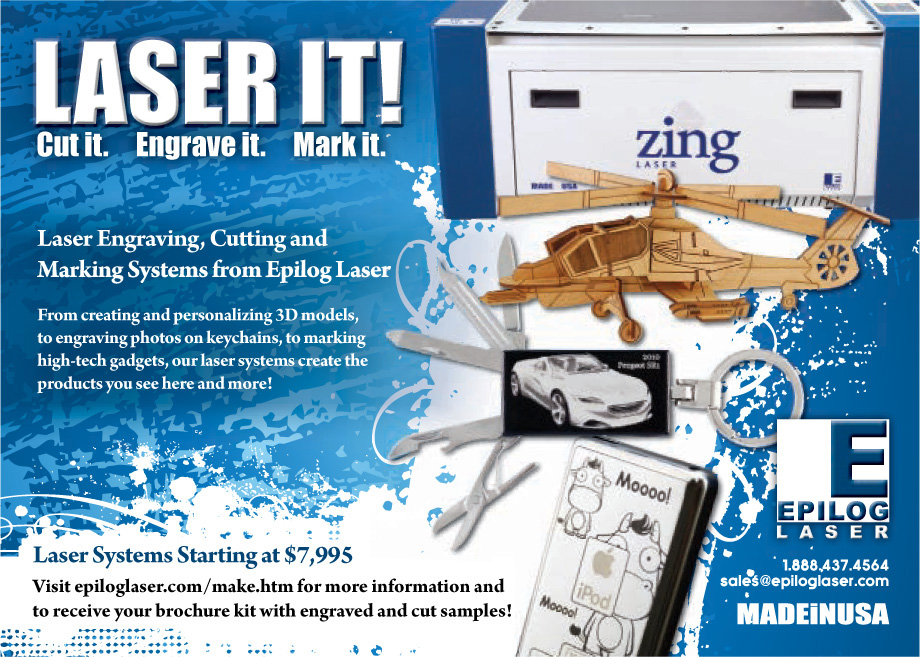TOOLBOX
Photograph planets, record audio tracks, grab a tarp, build a shack, find true north, and learn for free.

Imaging Source USB, FireWire, and Ethernet Cameras
$350 and up astronomycameras.com
Whether you need a planetary camera for astronomy or a “grown up” webcam for machine vision experiments, you’ll find Imaging Source’s products appealing. These sub-megapixel USB, FireWire, and gigabit Ethernet cameras shine because of their versatility.
With a sturdy, metal-bodied construction, they’re ideal for applications where a normal webcam would be too flimsy. The USB version requires no other power source. They work with all webcam software, and an especially versatile control program is included. All that’s missing is audio — there’s no microphone. And in some circumstances, that can be a blessing.
For astronomers, these are planetary cameras. The astronomy versions of the DMK (monochrome), DFK (color), and DBK (color plus infrared) cameras come with an adapter that fits a telescope eyepiece tube. Aim the telescope at a planet, record a few minutes of uncompressed video, then use RegiStax (freeware) to sort and align the video frames, picking out the best so you get the full benefit of brief moments of steady air. These cameras will take still pictures and time exposures, but they’re not designed for faint stars or nebulae.
For the rest of us, these are also general-purpose daytime cameras that accept C- and CS-mount video camera lenses. In this role they’re great for machine vision, security camera applications, and general experimenting.
If you write your own software, you can use either the regular webcam interface or a more versatile set of software tools available from the manufacturer. You can control the exposure over a much wider range than with a webcam, and unlike a DSLR, there’s no shutter to introduce vibration.
—Sharon Covington
Want more? Check out our searchable online database of tips and tools at makezine.com/tnt. Have a tool worth keeping in your toolbox? Let us know at [email protected].

RSVP Collapsible Silicone Funnel
$7 amzn.to/rsvpfunnel
Someone gave us this silicone funnel as a housewarming gift, and I looked cross-eyed at it before shoving it to the back of a drawer. But it turns out that we use it all the time. It’s been used to funnel olive oil, homemade limoncello, beans, rice, and filling for a door sock. (It’s also a big hit as a toddler toy.) The funnel is 4″ in diameter and 4″ tall when fully expanded, and it does in fact fit in the back of a drawer when collapsed. That gives it a big advantage over my old plastic funnel set, which practically needed a drawer to itself. It’s also easy to clean. I’m thinking of buying a second one (in a fun color) to keep in the car.
—Arwen O’Reilly Griffith
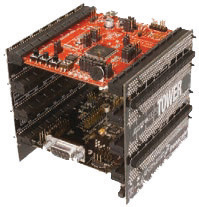
Freescale Tower Microcontroller System
Got a project to prototype? The basic Freescale Tower kit consists of the 32-bit microcontroller board with USB and RS-232 interfaces, accelerometer, four display LEDs, switches, and a potentiometer. Additional Tower modules are available, including different microcontrollers, an LCD graphic display, sensor board, wi-fi board, and a prototyping board.
The kit’s DVD contains the CodeWarrior IDE and supporting MQX software. It also includes 4 tutorial labs.
The Tower system is easy to set up and begin using. After experimenting with the labs, I was motivated to wire a solderless breadboard with light and temperature sensors to the Tower’s side expansion port, then modify the lab code to read these sensors remotely via the internet. No soldering needed! Freescale’s online documentation library makes project development easy.
—L. Abraham Smith, N3BAH
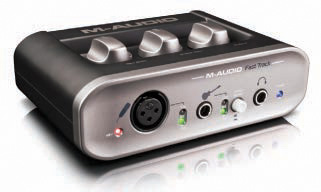
M-Audio Fast Track
$100 m-audio.com
I can remember a time when recording basic multitrack audio on a desktop computer was a daunting task and cost-prohibitive for most. Thankfully those days are behind us, and songwriters looking to record digitally have a number of affordable USB audio interfaces to choose from.
At about 100 bucks, the M-Audio Fast Track is one of the most affordable options in that category and (as it says on the box) aims to do one thing well: “record guitar and vocals on your computer.”
The unit sports both ¼″ instrument and XLR mic jacks (with 48V/phantom power) along with a ¼″ stereo jack for headphones. Resulting audio quality and usability are quite nice, and many will appreciate the device’s compatibility with the popular Pro Tools recording software (a limited version is included). Those looking to get acquainted with industry-standard DAWs will find this little number to be their “fastest track” to entry.
Oh, and if you have any trouble installing the included software on Mac OS 10.6.4 (like I did), be sure to check M-Audio’s site for an update.
—Collin Cunningham
MAKE OUTDOORS
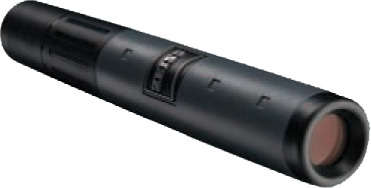
Zeiss MiniQuick
$170 zeiss.com
If you’ve ever wanted to have a telescope with you at all times, you need the Zeiss 5x10 MiniQuick. I found it easier to hold steady than other monoculars because of its finger-friendly design, and the eyepiece to eye distance is comfortable for glasses wearers. The image is very sharp but not as bright as regular binoculars, making it unsuitable for night sky observing. Turned around, it also functions as a 2x–5x magnifier, although with some barrel distortion. It can also be an optical test instrument or component in a larger system. Since it’s so lightweight, there’s little excuse to leave the house without it.
—SC
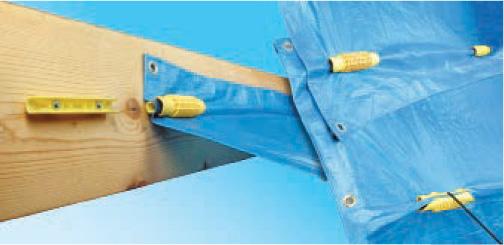
EZ Grabbit Premium Tarp Holders
$10 (4 to a package) grabbittool.com
I live in an old, leaky yurt. Given the rainy Northern California winters, this means I need a good tarp and a way to keep it tied down securely.
Thank goodness for these tarp holders. Each holder is made of two pieces, a “dog bone” and a “sleeve.” The dog bone goes under the tarp; holding it stationary, you slide the sleeve over the tarp and the dog bone to secure it in place. The dog bone can be connected to a rope or mounted to a structure for more permanent placement.
You can use these holders anywhere on your tarp (not just on the edge), and you can move and reuse them easily. The 4″-long surface area of the holder creates a very secure hold on the tarp — much better than a grommet, which can rip out with too much tension.
EZ Grabbit Tarp Holders can also be used to connect two tarps together to make a larger one, or to connect the edges of a tarp to create a big bag for moving yard waste.
—Terrie Schweitzer

Fiskars 28-Inch Pro Splitting Axe
$31 amzn.to/splittingax
When you need an axe to split firewood, you want one that’s sharp for good cutting and lightweight so it’s easier on your arms and shoulders. This splitting axe from Fiskars fits the bill nicely.
The fiberglass composite handle keeps the axe light but makes it stronger than wood-handled axes. The 2¼lb axe head takes and holds an edge well.
I’m not a champion wood-splitter, but this ax makes it easy for me to split my own kindling, and my burly friends can use it to fly through a stack of wood in no time.
— TS
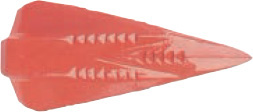
Wood Blaster Log Splitter Wedge
$10 amzn.to/splitterwedge
If you want to perform amazing feats of wood splitting, then you need a splitting “grenade” and a sledgehammer.
This splitting wedge has a unique design that exerts force in multiple directions, so it works better than a more traditional splitting wedge.
To use it, just tap it into the end of a log and pound it in with the sledgehammer. You’ll soon hear the satisfying crack of wood splitting.
This device makes a tough job much easier; you’ll be amazed at the size of logs you can split. And because there are no sharp edges, using this tool feels a lot safer than using a splitting axe with a lot of force.
Best of all, when you show your friends how it works, they’ll want to try it out themselves. You might feel a little like Tom Sawyer enticing his friends to whitewash the fence.
— TS

BodyGuardz Protective Films
$15–$30 bodyguardz.com
I bought an iPhone 4. “Helicopter glass,” I said in awe. But even helicopters get scratched up, so I never dared put anything else in my pocket but a hankie or a doggie doo bag. Nothing that could scratch my precious.
BodyGuardz gives you two sets of skins for your smartphone or iPad, plus lifetime replacements, for about 25 bucks. It’s the same tough polyurethane film that 3M sells to protect car paint from rocks, so it’s got a nice glassy shine and clarity. I can’t tell any difference in touchscreen sensitivity.
Application is a bit fussy — you spray a soap solution to temporarily deactivate the adhesive — but unlike “dry-apply” films, it allows unlimited do-overs to get it placed just right on your precious.
—Keith Hammond
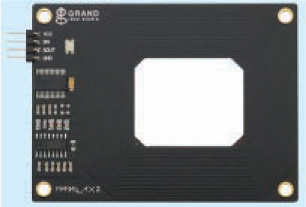
Parallax RFID Read/Write Module
$50 bit.ly/RFIDreadwrite
Parallax has introduced a new RFID module, representing the first economical, fully assembled RFID reader/writer for hobbyist use. The device allows writing of up to 116 bytes of 32-bit password-protectable data using a simple 9,600-baud asynchronous serial connection.
The manufacturer’s downloadable documentation provides full details on basic read/write commands. A “read legacy” command allows for reading of older style read-only tags. Command source code is downloadable for the BASIC Stamp 2 as well as Propeller object code. This makes it easy to serial interface with other micro-controllers such as Arduino.
The RFID read/write module is well constructed. The easy access and documented commands allowed me to integrate RFID into a hacked toy brainwave monitor I experimented with, so I could write the monitor’s session data to a log on the RFID card via a BASIC Stamp 2 interface.
—LAS

Protoflex Adapter
$60 protoflex.net
Protoflex is a cool new electronic prototyping product. These IC component adapters are made from thin flexible PCB materials with an adhesive backing. All you do is peel and stick. Why didn’t someone think of this before?
I assembled a prototype in only minutes by sticking the Protoflex adapters directly onto a thin plastic case without drilling holes or using a protoboard. It worked so fast I wanted to do it again.
Clever dual-hole solder patterns allow for through-hole or surface-mount wiring. The smaller hole pattern just fits a 30AWG wire and works great to hold it in place before soldering.
Protoflex panels come in SOIC, TSSOP/SSOP, SOT, SC-70, and DD-PAK IC devices plus adapters for Ribbon and D-Sub connectors. If you need to mount through-hole components, Protoflex even provides a special tool to align the flexible adapters to a 0.100″ pitch protoboard. These adapters will probably change the way we all build circuits.
—Tom Baycura
MAKE LOOKS AT BOOKS

House Proud
$19 relaxshacks.com
This 100% indie-produced book is a hoot, an education, and an inspiration, crammed with Derek “Deek” Diedricksen’s cartoony designs — from practical to pie-in-the-sky — for “micro-houses,” small backyard retreats, kid forts, treehouses, and other no-cost/low-cost outbuildings.
The emphasis here is on the fun and clever use of recycled materials. The book is obsessively illustrated with wonderfully wacky cartoons and design drawings or, as Deek describes it: “A carpal tunnel-inducing barrage of dime store pen sketches.” It all brims with Yankee ingenuity, junkyard philosophy, and plenty of eye-rolling yucks.
The funky energy of Humble Homes reminds me a lot of the Lloyd Kahn Shelter books, Malcolm Wells’ solar architecture books, and other handmade home books of the Whole Earth Catalog era. It’s all hand-lettered and drawn, hand-assembled, GBC-bound, and the printing was “trash-funded” by selling recyclables. It doesn’t get any more DIY than that!
—Gareth Branwyn

Spin Doctor
$30 McGraw-Hill
This book is designed to transition users of traditional unicore micro-controllers such as Arduino and PICs to the opportunities and design concerns presented by the octo-core Parallax Propeller microcontroller and its high-level Spin programming language.
After explaining the hardware differences in parallel processors and their relationship to the Spin programming language, the author presents a series of basic experiments demonstrating pulse-width modulation, control of LCD and LED displays, and reading analog input.
This is neither a rehash of the official Propeller Manual, nor a substitute; in fact, it’s a companion volume. Sandhu makes ample reference to Parallax documentation, providing deeper explanation of topics such as memory management, interfacing between the 3.3V Propeller and 5V peripherals, and the device’s 32-bit counters.
While the projects are presented in the context of the Parallax Educational Kit, no special components beyond a Propeller chip are needed for basic experiments. Supporting devices such as a 2×16 LCD display, switches, resistors, and potentiometers would be found in the junk box of most readers. Advanced projects are presented as well, covering parallel processing in the use of stepper and servomotors and accelerometers.
This book should find a place on any Propellerhead’s bookshelf, between Parallax’s Propeller Manual and its Programming and Customizing the Multicore Propeller volumes.
—LAS
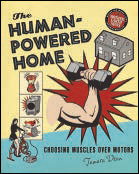
Muscles Over Motors
$30 New Society Publishers
I’ve been playing around with the idea of making my own pedal-powered devices for a while now, and am waiting no longer now that I’ve come across this great primer. The book kicks off with an extensive and fascinating history of human-driven devices and “appropriate” technology, moves to an accessible data-driven section on the efficiency of various human-machine interactions, and gives a crash course on bicycle engineering for the layperson.
Throughout, Tamara Dean weaves in inspiring and ingenious uses of human power in countries all over the world, as well as current devices on the market covering everything from lawn mowers to ice cream makers and cellphones. In case you find yourself getting too wrapped up in 19th-century bicycle designs, the book culminates in detailed descriptions and illustrations of projects for adapting various devices to a standard pedal setup. Go get your salvaged exercise bike now! All in all, Dean makes a fantastic argument for putting your body where your needs are.
—Meara O’Reilly

A Thing Only Its Maker Could Love
$28 Harper
“To increase your feelings of pride and ownership in your daily life, you should take a larger part in creating more of the things you use in your daily life,” writes Dan Ariely in his entertaining and insightful new book.
My own DIY experiences (which I wrote about in my book, Made by Hand: Searching for Meaning in a Throwaway World) confirm what Ariely wrote, but Ariely actually conducted a series of experiments to arrive at this conclusion. He’s a professor of psychology and a behavioral economist at Duke University, and this book (like his earlier bestseller, Predictably Irrational) explores the emotional side of human behavior regarding decisions about things of value.
The entire book is a joy to read, but the chapter about the satisfaction one gets from making stuff is especially interesting. Ariely’s experiments on test subjects who were asked to make simple objects under a variety of conditions revealed “four principles of human endeavor”: (1) Putting effort into making something not only changes the physical thing, it also changes the maker and the maker’s evaluation of the object. (2) The more effort we put into making something, the more we love it. (3) Not only do we tend to overvalue things we make ourselves, we assume that other people will like them as much as we do. (4) If we can’t finish a challenging project, we don’t feel attached to it.
Ariely’s conclusions now run through my mind as I make things, such as musical instruments. I really like my cigar box guitars (and I’m glad that I like them), but now I know that other people may not be as enamored of them as I am. That’s OK! Other people should be making, and loving, their own stuff.
—Mark Frauenfelder
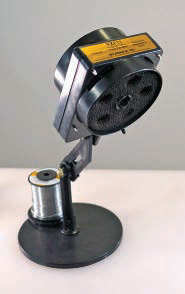
Edsyn FXF14 Fuminator Fume Extractor
$109 (not including filters) edsyn.com
A fume extractor is a simple device; it’s just a fan that pulls air from your work area through a filter and out the back of the unit. Ever since Marc de Vinck made one that fits in a mint tin for around $10 (see MAKE Volume 19, page 123), the price tag on retail models has seemed unnecessarily high. That said, Edsyn’s FXF14 (which is made in the USA) works great, has a small desktop footprint, and (in shiny, static-safe black) just plain looks good.
Edsyn claims its proprietary rotating filter system works eight times better than a stationary filter, and the pivoting head on the FXF14 makes it easy to get it close to your work. The fan is so quiet that sometimes I forget to turn the thing off.
I really enjoy mine and use it for soldering electronics as well as jewelry in my small apartment workshop. I usually feel a bit guilty after splurging on a fancy new tool, but your lungs can easily justify the investment of an effective (and attractive) benchtop solder-fume extractor.
—Becky Stern
Wikiversity Collaborative Learning
Free wikiversity.org
If I am nothing else, I am a student. For any skill I want to learn, I delve into books and websites, but unfortunately, not all skills can be learned without a classroom. Luckily, this problem is slowly disappearing with the introduction of the next level of Wikipedia — Wikiversity.
When I found this site by accident, I was elated. Normally, when I wanted to learn a new skill such as a foreign language, I was forced to find courses on local campuses that required tuition, or use online programs that cost several hundred dollars. With Wikiversity, I’m able to learn a language, practice with classmates, and use external references to keep learning.
The biggest drawback to Wikiversity is the lack of public awareness about it, which leads to a lack of participation. Some subjects aren’t covered in great depth, or covered at all. The best way to rectify this is to spread the news about Wikiversity. I encourage everyone, whether you’re a student or someone who has never been in a college setting, to give a Wikiversity course a try; you will be pleasantly enlightened.
—Eric Ponvelle

Iomega eGo BlackBelt Portable Hard Drive
$220 go.iomega.com
This excellent 1TB, 5,400rpm hard drive is not only the perfect portable drive, it’s great for desktop storage. When on the road, you don’t have to worry about dropping the device: Iomega claims the drive is shock resistant and able to withstand 84″ falls onto industrial carpeting. That, plus its small profile and 9.6oz weight, make it a cinch to carry around.
My favorite feature is that it gets power from the data cable. Not having an AC wall wart reduces desktop clutter and further reinforces its convenience as a traveling drive. On the Mac edition there are two FW800 ports (FW800 to 400 cable included) as well as one USB 2.0 port, while the PC version features USB 3.0. Either way, daisy-chaining is a given. Bonus extras include downloadable security software as well as a 3-year warranty.
—John Baichtal
Tricks of the Trade
Track true north.

Trying to find true north but don’t have a compass? Don’t worry. As long as you know the time, you can find your way.

This trick works on a watch if you have one, but if you don’t you can draw a clock face in the dirt or on some paper. Draw a circle, and within that, an hour hand pointing toward the sun.

Mark the current time where you drew your first line. Based on that, figure out where 12 would be and draw that in. If it’s currently daylight savings time (summer) use 1 instead of 12.

Bisect the angle between the current time and 12, and draw another line. North will be on the far side of that line from the sun as long as you’re in the non-tropical Northern Hemisphere.
Have a trick of the trade? Send it to [email protected].

Titan X2 Flash Laptop Case
$310 amzn.to/x2flashlaptop or titanluggageusa.com
The X2 is a badass laptop case with a hard shell, a thick foam-padded interior, and enough extra organizational compartments inside that it could work as a briefcase. In fact, it’s about the size of one and has a briefcase-style handle in addition to a removable shoulder strap.
Some people might get scared off by the hard shell, thinking it’ll weigh a ton. In fact, the Flash weighs only 3.3lbs empty, so you’ll be able to carry it easily on the bus. The hard shell offers great protection from ordinary dangers, but don’t expect much more (don’t let it get run over by a truck). Beyond the utilitarian angle, the Flash just looks sweet. Aside from a laptop, it’s perfect for transporting nuclear codes, biological samples, or the blueprints for a giant laser — and even if you don’t have anything like that to carry, the Flash totally looks the part.
—JB
Have you used something worth keeping in your toolbox? Let us know at [email protected].
